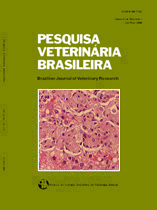 |
|
|
|
Year 2010 - Volume 30, Number 9
|

|
Nuclear and mitochondrial DNA markers in traceability of retail beef samples, 30(9):782-786
|
ABSTRACT.- Cesar A.S.M., Biase F.H., Ripamonte P., Luchiari Filho A., Merighe G.K. & Meirelles F.V. 2010. Nuclear and mitochondrial DNA markers in traceability of retail beef samples. Pesquisa Veterinária Brasileira 30(9):783-786. Laboratório de Morfofisiologia Molecular e Desenvolvimento, Faculdade de Zootecnia e Engenharia de Alimentos, Universidade de São Paulo, Av. Duque de Caxias Norte 225, Pirassununga, SP 13635-900, Brazil. E-mail: meirellf@usp.br
Several characteristics are important in a traceability system of animal products, such as age at slaughter, breed composition, besides information of the productive chain. In general, the certification agent records information about the animals and the system which it came from, although cannot guarantee that the slaughtering, meat processing and distribution are error proof. Besides, there is a differential price, at least at the international market, based on sex and breed composition of the animals. Genetic markers allow identification of characteristics controlled in the beef cattle traceability program, as sex and breed composition, in order to correctly identify and appraise the final product for the consumer. The hypothesis of this study was that the majority beef samples retailed in the local market originate from female with a great participation of zebu breeds. Therefore, the objective of this work was to characterize retail beef samples with DNA markers that identify cattle sex and breed composition. Within 10 beef shops localized in Pirassununga, SP, Brazil, 61 samples were collected, all were genotyped as harboring Bos taurus mitochondrial DNA and 18 were positive for the Y chromosome amplification (male). For the marker sat1711b-Msp I the frequency of the allele A was 0.278 and for the marker Lhr-Hha I the frequency of the allele T was 0.417. The results of sat1711b-Msp I and Lhr-Hha I allelic frequencies are suggestive that the proportion of indicus genome compared with the taurine genome in the market meat is smaller than the observed in the Nellore breed. The procedure described in this study identified sex and subspecies characteristics of beef meat samples, with potential application in meat products certification in special as an auxiliary tool in beef cattle traceability programs. |
| |
|
|
| |
|
 |